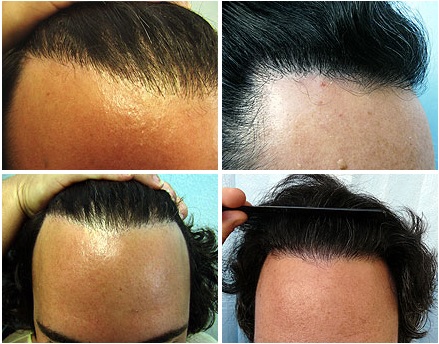leg hairs for hairline transplantation in Dermatology Times
Ilya Petrou MD one of the writers for the publication, authored a 2012 article entitled, Hair Affair- A Novel Way to Get A Leg Up On Male Pattern Baldness. She discusses how the ability to use fine leg hair grafts is helping to make it possible to create exceedingly realistic and natural looking hairlines in men.

Human Perception and the Hairline
Many balding men undoubtedly feel distraught by their dwindling hair count. Therefore they will often seek a sense of relief through modern hair transplant procedures which are able to transfer healthy follicles and thus create the appearance of fuller coverage.
However, coverage is only one attribute that is processed by others. People are keenly aware of the hair contour that frames the face. This is because our natural tendency is to look into a person’s eyes when speaking to them. And the hairline and temples are then easily noticed.
Subconsciously, we are aware that hairs along this contour are naturally much thinner and progress in thickness towards the back of the head. Therefore, when we see very thick hairs placed very orderly in the hairline and temples, this can strike us as odd.
Dr. Umar mentions that many of the patients who seek his help after undergoing hair surgeries at other clinics commonly complain how other people stare at their hairlines. And the constant nagging feelings of self consciousness drive them to seek revision for their results.
Hair transplant procedures have come a long way since the days of “hair plugs.” However, conventional methods have long used grafts taken from mid-occipital regions of the scalp, where hair is quite thick. Therefore, in order to create more natural looking hairlines, it becomes quite necessary to use much thinner grafts. In many people, leg hair offers an excellent resource for this purpose.
Using leg hairs for hairline transplantation
If thin hairs are available on different parts of the body and are essential for creating the best hairline and temples possible, then why haven’t doctors been using these grafts?
In Dermatology Times, Dr. Umar explains, “The hair on the body is angled more acutely than head hair. While head hair grows straight into the skin, leg hairs tend to grow with a little bit of angulation in the skin before it grows into the subcutaneous tissue.”
The removal of leg and body hair requires the use of tiny punches, 1mm or less. The general method of using punches, (as opposed to linear strip excisions) is known as Follicular Unit Extraction (FUE). However the typical design of the instruments applied for this purpose is a basic straight cylinder.
Given the fact that body hair grows at sharp angles, as described above by Dr. Umar, this type of structure presents a high risk of damaging the follicles.
Furthermore, leg and body hair are present on skin surfaces that are more delicate compared to head hair. While scarring from FUE occurs as small round dots, this type of manifestation would be highly noticeable.
Due to the challenges of graft damage and visible scarring, it is understandable why hair restoration doctors have long chosen to stay with the safer route of extracting donor grafts from the scalp.
leg hairs for hairline transplantation in Dermatology Times : Dr. Umar’s UGraft Revolution
In designing UGraft, his patented Advanced FUE technology, Dr. Umar reimagined the standard Follicular Unit Extraction punch to effectively address its limitations and create a reliable tool for removing leg and other hairs from different body regions.
Dermatology Times described the structure, features and capabilities of UGraft as being:
“a rotary tool mounted with modified hypodermic needles (19-20 gauge) and has specialized tips that allow for customized extraction.”
The article further explains that “the wounds created by the customized needle tips of the device widen with depth, resulting in diminished injury to the targeted follicles and in turn, accelerated wound closure.”
The advent of uGraft thus represents a new forward step in hair transplant procedures, giving practitioners a reliable way to attain thinner hairs, without the problematic issues presented by standard FUE punches.
UGraft is used for the extraction phase of hair restoration surgery. In order to avoid the creation of bald spots on the male leg, Dr. Umar purposely removes grafts in a diffuse pattern. Using the UGraft harvester, he is able to extract an average of 1000 leg follicular units within a 5-6 hour time frame.
Once the donor supply has been created, the insertion phase then takes place.With the supply of thinner grafts, the surgeon must then carefully insert the follicles to recreate natural angles, orientations and other patterns of hair growth. Petrou explains:
“The extracted follicular units are then grafted at the recipient transplant sites through custom-sized slits, matching the dimensions of the extracted grafts.”
Prior to the publication of Hair Affair by Dermatology Times, The Archives of Dermatology released another manuscript of Dr. Umar’s work using leg hair for hairline edges, citing real patient cases using this method. Individuals are able to achieve the full potential of their hairline at nine months. And the results of using these grafts have been documented to be fully thriving and sustained at four months following the surgery. Therefore, those considering the use of leg hair for natural looking hairlines can rest assured that their results will last long term.

Read the actual article published by Dermatology Times here:
Dermatology Times|Hair Affair- A Novel Way To Get A Leg Up On Male Pattern Baldness| 2012
